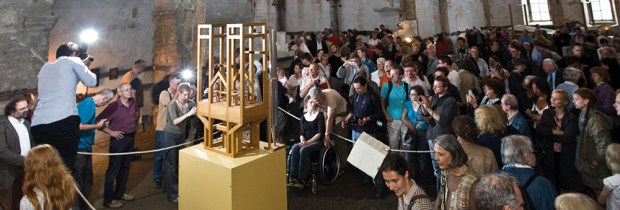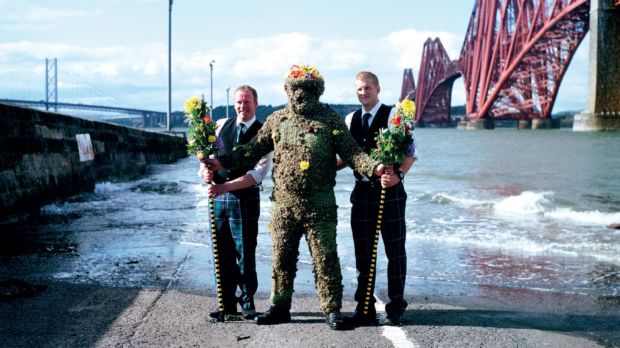Like most of our ape ancestors, we have really had only one response to the fall of night. We have stretched and yawned, we have climbed upwards, we’ve lain down somewhere soft, closed our eyes and shut the whole thing out until morning. Humans may have exchanged tree trunks for a set of stairs, and bunches of green leaves for sprung mattresses, but the same basic reflex has been ongoing among large primates for four million years.
The new exhibition at the Natural History Museum, Life in the Dark, reveals to us a little of what and who we have been missing as a result of our diurnal bias. Not surprisingly, it turns out that night-time is peopled with creatures that we find scary. The show includes some of our favourite cast members from the horror genre: sharks, snakes, vampire bats — even vampire squid — scorpions, giant cockroaches and whip spiders. One senses that many of these wonderful animals were selected with children in mind, and I imagine that the creators got huge pleasure in anticipating the impact of some of the skin-crawling exhibits.
A good example is the screen illuminating what a pit viper can detect in conditions of total darkness. The snake has a cavity called a fossa between the eyes that enables it to see in the infrared spectrum. You realise that the portrait flashing up as you walk past, which shows your face as a sickly white cavity and your clothed body in shades of glowing yellow and pink, is not just a weird heat-generated selfie; it is a precise image of what a snake would see if it struck.
However the scariest, if also funniest, moment comes in an early part of the exhibition, where we are invited to explore the sensory adaptations required for a nocturnal lifestyle. Creatures that forego some of the benefits of daylight make up for that with other highly evolved capacities. In matters of touch we are asked to ponder the multitudinous sensors present in the proboscis of a star-nosed mole. We are also invited to stick our fingers blindly into a dark hole in the wall and see what we can feel. Suddenly something ghastly — a pit viper, perhaps, or whip spider? — gropes your hand. I must confess I jumped back with embarrassing speed.
It turns out to simulate a dormouse — a soft, gingery-furred mammal that makes endearing balls of leaves and grasses to snuggle into among British woodland. To be precise, it is a recreation of the ‘whisking’ action performed by the vibrissae smothering the face of this adorable creature. The constant sweeping of the specialised hairs enables dormice to map their environments and overcome the challenges of low-light conditions.
This is the best joke, but it is part ofa wider, laudable attempt to make Life in the Dark an interactive experience, especially for children, who can see the exhibition for free. One nicely ironic detail is a sign saying ‘Please Touch’ alongside stuffed skins of a real rabbit, fox, owl and badger. There are various buttons to press to get a full draught of the smells that drive the nocturnal lifestyles of various animals.
You can sample the nectary odours that flying foxes follow to locate their fruit-tree diet. One offers the lemon-scented pheromones that enable male sphinx moths to track down the whereabouts of prospective mates. My favourite was a deep sweet musk — the perfume coming from earthworms that kiwis can pick out via olfactory organs in their beak tips as they probe in forest humus.
I would have wished the creators of the exhibition to have gone further with this interactive experience. There is just a single live species on display: a tank of Mexican tetra fish which, in adapting to life in underground caves, have not only lost vision, they have no eyes at all. Getting eyeball to empty socket with these weirdly beautiful animals is affecting. Yet this is the whole of our encounter with real life. Sometimes we have to be content with looking at specimens in preserving jars that were bottled up in the 1920s. Occasionally, it is difficult even to make out what manner of creature is held there.
This is a museum, of course, but within ten, certainly 20, miles of the building there are multitudinous opportunities to have real encounters with many of the creatures exhibited here — living foxes, badgers, owls, nightjars, crickets, bats, moths, to namea few. There are also any number of wildlife organisations that could be collaborative partners to extend any visit, especially those of children, into something far more viscerally engaging. I vividly recall my first nocturnal walk to see and hear owls in the wood.I wonder if young visitors will remember this exhibition in 50 years’ time?
There is a point to this, which the Life in the Dark show makes explicit. Human impacts upon many of the animals displayed have been catastrophic, with wildlife populations declining worldwide by 58 per cent in the past 40 years. We need not only to engage but to do more to protect nature. One information panel says that human light pollution is now increasing annually. There is so much ambient light that previously diurnal animals are switching to hunt at night, while strictly nocturnal creatures, such as the astonishing boat-billed heron, are assailed as never before.
Like all good entertainers, the museum staff save their best until last, with a series of exhibits of deep-sea creatures. Moving through rooms in virtual darkness, illuminated only by a thousand pinpoints of light overhead, as if we could be transported to these benthic depths, we are asked to contemplate animals of which most of us will never have heard. Here are the threadfin dragonfish, the cookiecutter shark, the sixgill hagfish — names alone that set the imagination racing.
One can forgive that these otherworldly creatures are represented only by preserved specimens. Weirdest of all, perhaps, is a thing known as the Atlantic footballfish. Bulbous and spectral white, and less like a whole animal than a haunch of fatty tissue extracted from some other creature, it dwells 3,000 feet below the surface of the ocean. The one recognisable organ is a weird thread-like appendage dangling from its head. This generates bioluminescence and lures in prey to within inches of its glass-splinter teeth.
Life in the Dark is compelling and memorable, introducing the visitor to some of the least-known animals on Earth. It demonstrates how so many of our fellow inhabitants are still beyond our ken simply because we dwell by day and they live by night. Yet it also reaffirms that all parts of our universe are interconnected. The rather humble dung beetle makes the point beautifully.
You have to get down close to the glass case even to see these insects dimly in the half-light. Then you learn that dung beetles, as they scuttle across the desert sands in the dark, pushing a camel turd as they go, will navigate in a straight line by following the path of light of the Milky Way in the sky above their heads. I dare you not to be moved.
Got something to add? Join the discussion and comment below.
Get 10 issues for just $10
Subscribe to The Spectator Australia today for the next 10 magazine issues, plus full online access, for just $10.
You might disagree with half of it, but you’ll enjoy reading all of it. Try your first month for free, then just $2 a week for the remainder of your first year.

![Let there be light: the Atlantic footballfish dwells 3,000 feet below the surface of the ocean. [Paulo Oliveira / Alamy Stock Photo]](https://www.spectator.com.au/wp-content/uploads/2018/08/18augartslead.jpg?w=730&h=486&crop=1)












Comments
Don't miss out
Join the conversation with other Spectator Australia readers. Subscribe to leave a comment.
SUBSCRIBEAlready a subscriber? Log in